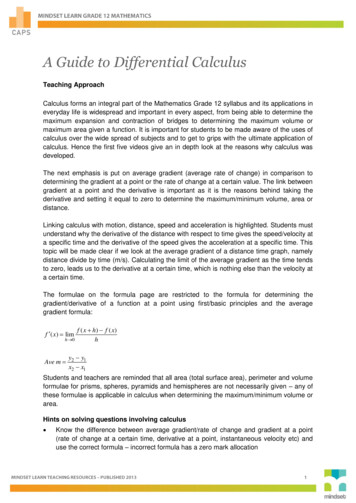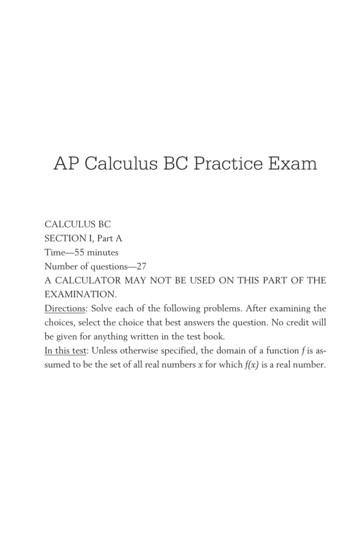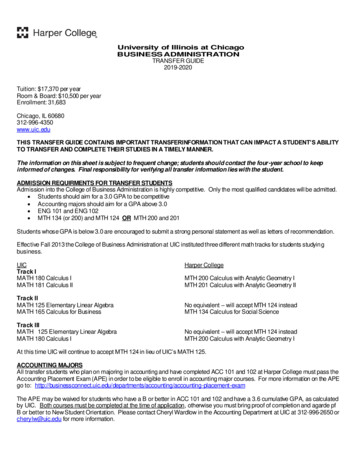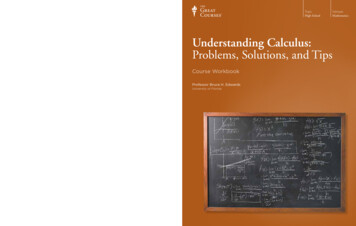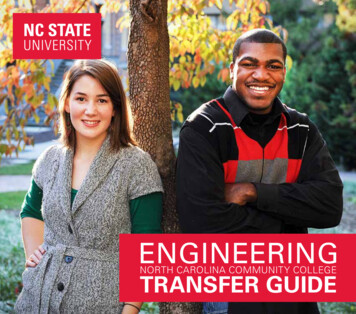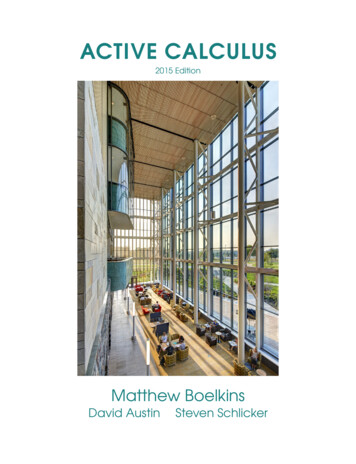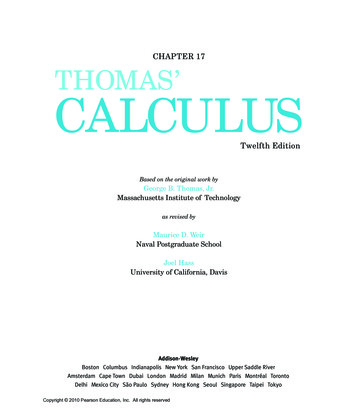
Transcription
CHAPTER 17THOMAS’CALCULUSTwelfth EditionBased on the original work byGeorge B. Thomas, Jr.Massachusetts Institute of Technologyas revised byMaurice D. WeirNaval Postgraduate SchoolJoel HassUniversity of California, DavisCopyright 2010 Pearson Education, Inc. All rights reserved
Editor-in-Chief: Deirdre LynchSenior Acquisitions Editor: William HoffmanSenior Project Editor: Rachel S. ReeveAssociate Editor: Caroline CelanoAssociate Project Editor: Leah GoldbergSenior Managing Editor: Karen WernholmSenior Production Supervisor: Sheila SpinneySenior Design Supervisor: Andrea NixDigital Assets Manager: Marianne GrothMedia Producer: Lin MahoneySoftware Development: Mary Durnwald and Bob CarrollExecutive Marketing Manager: Jeff WeidenaarMarketing Assistant: Kendra BassiSenior Author Support/Technology Specialist: Joe VetereSenior Prepress Supervisor: Caroline FellManufacturing Manager: Evelyn BeatonProduction Coordinator: Kathy DiamondComposition: Nesbitt Graphics, Inc.Illustrations: Karen Heyt, IllustraTechCover Design: Rokusek DesignCover image: Forest Edge, Hokuto, Hokkaido, Japan 2004 Michael KennaAbout the cover: The cover image of a tree line on a snow-swept landscape, by the photographer Michael Kenna,was taken in Hokkaido, Japan. The artist was not thinking of calculus when he composed the image, but rather, of avisual haiku consisting of a few elements that would spark the viewer’s imagination. Similarly, the minimal designof this text allows the central ideas of calculus developed in this book to unfold to ignite the learner’s imagination.For permission to use copyrighted material, grateful acknowledgment is made to the copyright holders on page C-1,which is hereby made part of this copyright page.Many of the designations used by manufacturers and sellers to distinguish their products are claimed as trademarks.Where those designations appear in this book, and Addison-Wesley was aware of a trademark claim, the designations have been printed in initial caps or all caps.Library of Congress Cataloging-in-Publication DataWeir, Maurice D.Thomas’ Calculus / Maurice D. Weir, Joel Hass, George B. Thomas.—12th ed.p. cmISBN 978-0-321-58799-21. Calculus—Textbooks. I. Hass, Joel. II. Thomas, George B. (George Brinton), 1914–2006. III. Thomas,George B. (George Brinton), 1914–2006. Calculus. IV. Title V. Title: Calculus.QA303.2.W45 2009b515–dc222009023069Copyright 2010, 2007, 2004 Pearson Education, Inc. All rights reserved. No part of this publication may bereproduced, stored in a retrieval system, or transmitted, in any form or by any means, electronic, mechanical,photocopying, recording, or otherwise, without the prior written permission of the publisher. Printed in the UnitedStates of America. For information on obtaining permission for use of material in this work, please submit a writtenrequest to Pearson Education, Inc., Rights and Contracts Department, 501 Boylston Street, Suite 900, Boston, MA02116, fax your request to 617-848-7047, or e-mail at http://www.pearsoned.com/legal/permissions.htm.1 2 3 4 5 6 7 8 9 10—CRK—12 11 10 09www.pearsoned.comCopyright 2010 Pearson Education, Inc. All rights reservedISBN-10: 0-321-58799-5ISBN-13: 978-0-321-58799-2
Chapter17SECOND-ORDERDIFFERENTIAL EQUATIONSOVERVIEW In this chapter we extend our study of differential equations to those of secondorder. Second-order differential equations arise in many applications in the sciences andengineering. For instance, they can be applied to the study of vibrating springs and electriccircuits. You will learn how to solve such differential equations by several methods in thischapter.17.1Second-Order Linear EquationsAn equation of the formP(x)y–(x) Q(x)y¿(x) R(x)y(x) G(x),(1)which is linear in y and its derivatives, is called a second-order linear differential equation. We assume that the functions P, Q, R, and G are continuous throughout some openinterval I. If G(x) is identically zero on I, the equation is said to be homogeneous; otherwise it is called nonhomogeneous. Therefore, the form of a second-order linear homogeneous differential equation isP(x)y– Q(x)y¿ R(x)y 0.(2)We also assume that P(x) is never zero for any x H I .Two fundamental results are important to solving Equation (2). The first of these saysthat if we know two solutions y1 and y2 of the linear homogeneous equation, then anylinear combination y c1 y1 c2 y2 is also a solution for any constants c1 and c2.THEOREM 1—The Superposition PrincipleIf y1(x) and y2(x) are two solutionsto the linear homogeneous equation (2), then for any constants c1 and c2, thefunctiony(x) c1 y1(x) c2 y2(x)is also a solution to Equation (2).Copyright 2010 Pearson Education, Inc. All rights reserved17-1
17-2Chapter 17: Second-Order Differential EquationsProof Substituting y into Equation (2), we haveP(x)y– Q(x)y¿ R(x)yP(x)(c1 y1 c2 y2)– Q(x)(c1 y1 c2 y2)¿ R(x)(c1 y1 c2 y2)P(x)(c1 y1 – c2 y2 –) Q(x)(c1 y1 ¿ c2 y2 ¿) R(x)(c1 y1 c2 y2)c1(P(x)y1 – Q(x)y1 ¿ R(x)y1) c2(P(x)y2 – Q(x)y2 ¿ R(x)y2)144442444443144442444443 0, y1 is a solution 0, y2 is a solution c1(0) c2(0) 0.Therefore, y c1 y1 c2 y2 is a solution of Equation (2).Theorem 1 immediately establishes the following facts concerning solutions to thelinear homogeneous equation.1.2.3.A sum of two solutions y1 y2 to Equation (2) is also a solution. (Choose c1 c2 1.)A constant multiple ky1 of any solution y1 to Equation (2) is also a solution. (Choosec1 k and c2 0.)The trivial solution y(x) K 0 is always a solution to the linear homogeneous equation. (Choose c1 c2 0.)The second fundamental result about solutions to the linear homogeneous equationconcerns its general solution or solution containing all solutions. This result says thatthere are two solutions y1 and y2 such that any solution is some linear combination of themfor suitable values of the constants c1 and c2. However, not just any pair of solutions willdo. The solutions must be linearly independent, which means that neither y1 nor y2 is aconstant multiple of the other. For example, the functions ƒ(x) e x and g(x) xe x arelinearly independent, whereas ƒ(x) x 2 and g(x) 7x 2 are not (so they are linearly dependent). These results on linear independence and the following theorem are proved inmore advanced courses.THEOREM 2If P, Q, and R are continuous over the open interval I and P(x) isnever zero on I, then the linear homogeneous equation (2) has two linearlyindependent solutions y1 and y2 on I. Moreover, if y1 and y2 are any two linearlyindependent solutions of Equation (2), then the general solution is given byy(x) c1 y1(x) c2 y2(x),where c1 and c2 are arbitrary constants.We now turn our attention to finding two linearly independent solutions to the specialcase of Equation (2), where P, Q, and R are constant functions.Constant-Coefficient Homogeneous EquationsSuppose we wish to solve the second-order homogeneous differential equationay– by¿ cy 0,Copyright 2010 Pearson Education, Inc. All rights reserved(3)
17.1 Second-Order Linear Equations17-3where a, b, and c are constants. To solve Equation (3), we seek a function which whenmultiplied by a constant and added to a constant times its first derivative plus a constanttimes its second derivative sums identically to zero. One function that behaves this way isthe exponential function y e rx, when r is a constant. Two differentiations of this exponential function give y¿ re rx and y– r 2e rx, which are just constant multiples of theoriginal exponential. If we substitute y e rx into Equation (3), we obtainar 2e rx bre rx ce rx 0.Since the exponential function is never zero, we can divide this last equation through bye rx. Thus, y e rx is a solution to Equation (3) if and only if r is a solution to the algebraicequationar 2 br c 0.(4)Equation (4) is called the auxiliary equation (or characteristic equation) of the differential equation ay– by¿ cy 0. The auxiliary equation is a quadratic equation withrootsr1 - b 2b 2 - 4ac2aandr2 - b - 2b 2 - 4ac.2aThere are three cases to consider which depend on the value of the discriminant b 2 - 4ac.Case 1: b2 4ac 0. In this case the auxiliary equation has two real and unequal rootsr1 and r2. Then y1 e r1 x and y2 e r2 x are two linearly independent solutions to Equation(3) because e r2 x is not a constant multiple of e r1 x (see Exercise 61). From Theorem 2 weconclude the following result.THEOREM 3If r1 and r2 are two real and unequal roots to the auxiliaryequation ar 2 br c 0, theny c1e r1 x c2e r2 xis the general solution to ay– by¿ cy 0.EXAMPLE 1Find the general solution of the differential equationy– - y¿ - 6y 0.Solution Substitution of y e rx into the differential equation yields the auxiliaryequationr 2 - r - 6 0,which factors as(r - 3)(r 2) 0.The roots are r1 3 and r2 - 2. Thus, the general solution isy c1e 3x c2e -2x.Copyright 2010 Pearson Education, Inc. All rights reserved
17-4Chapter 17: Second-Order Differential EquationsCase 2: b2 4ac 0. In this case r1 r2 - b 2a. To simplify the notation, letr - b 2a. Then we have one solution y1 e rx with 2ar b 0. Since multiplicationof e rx by a constant fails to produce a second linearly independent solution, suppose we trymultiplying by a function instead. The simplest such function would be u(x) x, so let’ssee if y2 xe rx is also a solution. Substituting y2 into the differential equation givesay2 – by2 ¿ cy2 a(2re rx r 2xe rx ) b(e rx rxe rx ) cxe rx (2ar b)e rx (ar 2 br c)xe rx 0(e rx ) (0)xe rx 0.The first term is zero because r - b 2a; the second term is zero because r solves theauxiliary equation. The functions y1 e rx and y2 xe rx are linearly independent (seeExercise 62). From Theorem 2 we conclude the following result.THEOREM 4If r is the only (repeated) real root to the auxiliary equationar 2 br c 0, theny c1e rx c2 xe rxis the general solution to ay– by¿ cy 0.EXAMPLE 2Find the general solution toy– 4y¿ 4y 0.Solution The auxiliary equation isr 2 4r 4 0,which factors into(r 2) 2 0.Thus, r - 2 is a double root. Therefore, the general solution isy c1e -2x c2 xe -2x.Case 3: b2 4ac 0. In this case the auxiliary equation has two complex rootsr1 a ib and r2 a - ib , where a and b are real numbers and i 2 - 1. (These realnumbers are a - b 2a and b 24ac - b 2 2a.) These two complex roots then giverise to two linearly independent solutionsy1 e (a ib)x e ax(cos bx i sin bx) andy2 e (a - ib)x e ax(cos bx - i sin bx).(The expressions involving the sine and cosine terms follow from Euler’s identity in Section 9.9.) However, the solutions y1 and y2 are complex valued rather than real valued.Nevertheless, because of the superposition principle (Theorem 1), we can obtain fromthem the two real-valued solutionsy3 11y y2 e ax cos bx2 12andy4 11y y e ax sin bx.2i 12i 2The functions y3 and y4 are linearly independent (see Exercise 63). From Theorem 2 weconclude the following result.Copyright 2010 Pearson Education, Inc. All rights reserved
17.1 Second-Order Linear Equations17-5THEOREM 5If r1 a ib and r2 a - ib are two complex roots to theauxiliary equation ar 2 br c 0, theny e ax(c1 cos bx c2 sin bx)is the general solution to ay– by¿ cy 0.EXAMPLE 3Find the general solution to the differential equationy– - 4y¿ 5y 0.Solution The auxiliary equation isr 2 - 4r 5 0.The roots are the complex pair r (4 ; 216 - 20) 2 or r1 2 i and r2 2 - i.Thus, a 2 and b 1 give the general solutiony e 2x(c1 cos x c2 sin x).Initial Value and Boundary Value ProblemsTo determine a unique solution to a first-order linear differential equation, it was sufficientto specify the value of the solution at a single point. Since the general solution to a secondorder equation contains two arbitrary constants, it is necessary to specify two conditions.One way of doing this is to specify the value of the solution function and the value of itsderivative at a single point: y(x0) y0 and y¿(x0) y1. These conditions are called initialconditions. The following result is proved in more advanced texts and guarantees the existence of a unique solution for both homogeneous and nonhomogeneous second-orderlinear initial value problems.THEOREM 6If P, Q, R, and G are continuous throughout an open interval I,then there exists one and only one function y(x) satisfying both the differentialequationP(x)y–(x) Q(x)y¿(x) R(x)y(x) G(x)on the interval I, and the initial conditionsy(x0) y0andy¿(x0) y1at the specified point x0 H I .It is important to realize that any real values can be assigned to y0 and y1 and Theorem 6applies. Here is an example of an initial value problem for a homogeneous equation.Copyright 2010 Pearson Education, Inc. All rights reserved
17-6Chapter 17: Second-Order Differential EquationsEXAMPLE 4Find the particular solution to the initial value problemy– - 2y¿ y 0,y(0) 1,y¿(0) - 1.Solution The auxiliary equation isr 2 - 2r 1 (r - 1) 2 0.yThe repeated real root is r 1, giving the general solution–4 –3–2–101–2y ex–y c1e x c2 xe x.xThen,2xe xy¿ c1e x c2(x 1)e x.–4From the initial conditions we have–6–8FIGURE 17.1 Particular solution curvefor Example 4.1 c1 c2 # 0and-1 c1 c2 # 1.Thus, c1 1 and c2 - 2. The unique solution satisfying the initial conditions isy e x - 2xe x.The solution curve is shown in Figure 17.1.Another approach to determine the values of the two arbitrary constants in the generalsolution to a second-order differential equation is to specify the values of the solutionfunction at two different points in the interval I. That is, we solve the differential equationsubject to the boundary valuesandy(x1) y1y(x2) y2,where x1 and x2 both belong to I. Here again the values for y1 and y2 can be any realnumbers. The differential equation together with specified boundary values is called aboundary value problem. Unlike the result stated in Theorem 6, boundary value problems do not always possess a solution or more than one solution may exist (see Exercise65). These problems are studied in more advanced texts, but here is an example for whichthere is a unique solution.EXAMPLE 5Solve the boundary value problemy– 4y 0,y(0) 0,yapb 1.12Solution The auxiliary equation is r 2 4 0, which has the complex roots r ; 2i.The general solution to the differential equation isy c1 cos 2x c2 sin 2x.The boundary conditions are satisfied ify(0) c1 # 1 c2 # 0 0yapppb c1 cos a b c2 sin a b 1.1266It follows that c1 0 and c2 2. The solution to the boundary value problem isy 2 sin 2x.Copyright 2010 Pearson Education, Inc. All rights reserved
17.1 Second-Order Linear Equations17-7EXERCISES 17.1In Exercises 1–30, find the general solution of the given equation.In Exercises 41–55, find the general solution.1. y– - y¿ - 12y 02. 3y– - y¿ 041. y– - 2y¿ - 3y 042. 6y– - y¿ - y 03. y– 3y¿ - 4y 04. y– - 9y 043. 4y– 4y¿ y 044. 9y– 12y¿ 4y 05. y– - 4y 06. y– - 64y 045. 4y– 20y 046. y– 2y¿ 2y 08. 9y– - y 07. 2y– - y¿ - 3y 047. 25y– 10y¿ y 048. 6y– 13y¿ - 5y 010. 3y– - 20y¿ 12y 049. 4y– 4y¿ 5y 050. y– 4y¿ 6y 011. y– 9y 012. y– 4y¿ 5y 051. 16y– - 24y¿ 9y 052. 6y– - 5y¿ - 6y 013. y– 25y 014. y– y 053. 9y– 24y¿ 16y 054. 4y– 16y¿ 52y 015. y– - 2y¿ 5y 016. y– 16y 055. 6y– - 5y¿ - 4y 017. y– 2y¿ 4y 018. y– - 2y¿ 3y 0In Exercises 56–60, solve the initial value problem.19. y– 4y¿ 9y 020. 4y– - 4y¿ 13y 056. y– - 2y¿ 2y 0,21. y– 0dyd 2y 4 4y 023.dxdx 22dyd y 6 9y 025.2dxdx22. y– 8y¿ 16y 0d 2ydy- 6 9y 024.dxdx 22d ydy 9y 026. 4 2 - 12dxdx57. y– 2y¿ y 0,9. 8y– - 10y¿ - 3y 027. 4d 2y2dxd 2y 4dy y 0dxdy y 029. 9 2 6dxdx28. 4d 2y2dxd 2y- 4dy y 0dxdy 4y 030. 9 2 - 12dxdxIn Exercises 31–40, find the unique solution of the second-orderinitial value problem.31. y– 6y¿ 5y 0,y(0) 0, y¿(0) 332. y– 16y 0,y(0) 2, y¿(0) - 233. y– 12y 0,y(0) 0, y¿(0) 134. 12y– 5y¿ - 2y 0,35. y– 8y 0,y(0) 1, y¿(0) - 1y(0) - 1, y¿(0) 236. y– 4y¿ 4y 0,y(0) 0, y¿(0) 137. y– - 4y¿ 4y 0,y(0) 1, y¿(0) 038. 4y– - 4y¿ y 0, y(0) 4, y¿(0) 4d 2ydydy 9y 0, y(0) 2,(0) 139. 4 2 12dxdxdxdydyd 2y 4y 0, y(0) - 1,(0) 140. 9 2 - 12dxdxdxCopyright 2010 Pearson Education, Inc. All rights reservedy(0) 0, y¿(0) 2y(0) 1, y¿(0) 158. 4y– - 4y¿ y 0,y(0) - 1, y¿(0) 259. 3y– y¿ - 14y 0,y(0) 2, y¿(0) - 160. 4y– 4y¿ 5y 0,y(p) 1, y¿(p) 061. Prove that the two solution functions in Theorem 3 are linearly independent.62. Prove that the two solution functions in Theorem 4 are linearly independent.63. Prove that the two solution functions in Theorem 5 are linearly independent.64. Prove that if y1 and y2 are linearly independent solutions to thehomogeneous equation (2), then the functions y3 y1 y2 andy4 y1 - y2 are also linearly independent solutions.65. a. Show that there is no solution to the boundary value problemy– 4y 0,y(0) 0, y(p) 1.b. Show that there are infinitely many solutions to the boundaryvalue problemy– 4y 0, y(0) 0, y(p) 0.66. Show that if a, b, and c are positive constants, then all solutions ofthe homogeneous differential equationay– by¿ cy 0approach zero as x : q .
17-8Chapter 17: Second-Order Differential Equations17.2Nonhomogeneous Linear EquationsIn this section we study two methods for solving second-order linear nonhomogeneousdifferential equations with constant coefficients. These are the methods of undeterminedcoefficients and variation of parameters. We begin by considering the form of the generalsolution.Form of the General SolutionSuppose we wish to solve the nonhomogeneous equationay– by¿ cy G(x),(1)where a, b, and c are constants and G is continuous over some open interval I. Letyc c1 y1 c2 y2 be the general solution to the associated complementary equationay– by¿ cy 0.(2)(We learned how to find yc in Section 17.1.) Now suppose we could somehow come upwith a particular function yp that solves the nonhomogeneous equation (1). Then the sumy yc yp(3)also solves the nonhomogeneous equation (1) becausea(yc yp)– b(yc yp)¿ c( yc yp) (ayc – byc ¿ cyc) (ayp – byp ¿ cyp) 0 G(x)yc solves Eq. (2) and yp solves Eq. (1) G(x).Moreover, if y y(x) is the general solution to the nonhomogeneous equation (1), it musthave the form of Equation (3). The reason for this last statement follows from the observation that for any function yp satisfying Equation (1), we havea(y - yp)– b(y - yp)¿ c( y - yp) (ay– by¿ cy) - (ayp – byp ¿ cyp) G(x) - G(x) 0.Thus, yc y - yp is the general solution to the homogeneous equation (2). We haveestablished the following result.THEOREM 7The general solution y y(x) to the nonhomogeneous differential equation (1) has the formy yc yp,where the complementary solution yc is the general solution to the associatedhomogeneous equation (2) and yp is any particular solution to the nonhomogeneous equation (1).Copyright 2010 Pearson Education, Inc. All rights reserved
17.2 Nonhomogeneous Linear Equations17-9The Method of Undetermined CoefficientsThis method for finding a particular solution yp to the nonhomogeneous equation (1) applies to special cases for which G(x) is a sum of terms of various polynomials p(x) multiplying an exponential with possibly sine or cosine factors. That is, G(x) is a sum of termsof the following forms:p1(x)e rx,p2(x)e ax cos bx,p3(x)e ax sin bx.For instance, 1 - x, e 2x, xe x, cos x, and 5e x - sin 2x represent functions in this category.(Essentially these are functions solving homogeneous linear differential equations withconstant coefficients, but the equations may be of order higher than two.) We now presentseveral examples illustrating the method.EXAMPLE 1Solve the nonhomogeneous equation y– - 2y¿ - 3y 1 - x 2.Solution The auxiliary equation for the complementary equation y– - 2y¿ - 3y 0 isr 2 - 2r - 3 (r 1)(r - 3) 0.It has the roots r - 1 and r 3 giving the complementary solutionyc c1e - x c2e 3x.Now G(x) 1 - x 2 is a polynomial of degree 2. It would be reasonable to assume that aparticular solution to the given nonhomogeneous equation is also a polynomial of degree 2because if y is a polynomial of degree 2, then y– - 2y¿ - 3y is also a polynomial of degree 2. So we seek a particular solution of the formyp Ax 2 Bx C.We need to determine the unknown coefficients A, B, and C. When we substitute the polynomial yp and its derivatives into the given nonhomogeneous equation, we obtain2A - 2(2Ax B) - 3(Ax 2 Bx C) 1 - x 2or, collecting terms with like powers of x,-3Ax 2 ( -4A - 3B)x (2A - 2B - 3C) 1 - x 2.This last equation holds for all values of x if its two sides are identical polynomials ofdegree 2. Thus, we equate corresponding powers of x to get- 3A - 1,-4A - 3B 0,2A - 2B - 3C 1.andThese equations imply in turn that A 1 3, B -4 9, and C 5 27. Substituting thesevalues into the quadratic expression for our particular solution givesyp 51 24.x - x 3927By Theorem 7, the general solution to the nonhomogeneous equation isy yc yp c1e - x c2e 3x Copyright 2010 Pearson Education, Inc. All rights reserved51 24.x - x 3927
17-10Chapter 17: Second-Order Differential EquationsEXAMPLE 2Find a particular solution of y– - y¿ 2 sin x.Solution If we try to find a particular solution of the formyp A sin xand substitute the derivatives of yp in the given equation, we find that A must satisfy theequation- A sin x A cos x 2 sin xfor all values of x. Since this requires A to equal both - 2 and 0 at the same time, we conclude that the nonhomogeneous differential equation has no solution of the form A sin x.It turns out that the required form is the sumyp A sin x B cos x.The result of substituting the derivatives of this new trial solution into the differentialequation is-A sin x - B cos x - (A cos x - B sin x) 2 sin xor(B - A) sin x - (A B) cos x 2 sin x.This last equation must be an identity. Equating the coefficients for like terms on each sidethen givesB - A 2andA B 0.Simultaneous solution of these two equations gives A - 1 and B 1. Our particularsolution isyp cos x - sin x.EXAMPLE 3Find a particular solution of y– - 3y¿ 2y 5e x.Solution If we substituteyp Ae xand its derivatives in the differential equation, we find thatAe x - 3Ae x 2Ae x 5e xor0 5e x.However, the exponential function is never zero. The trouble can be traced to the fact thaty e x is already a solution of the related homogeneous equationy– - 3y¿ 2y 0.The auxiliary equation isr 2 - 3r 2 (r - 1)(r - 2) 0,which has r 1 as a root. So we would expect Ae x to become zero when substituted intothe left-hand side of the differential equation.The appropriate way to modify the trial solution in this case is to multiply Ae x by x.Thus, our new trial solution isCopyright 2010 Pearson Education, Inc. All rights reservedyp Axe x.
17.2 Nonhomogeneous Linear Equations17-11The result of substituting the derivatives of this new candidate into the differential equation is(Axe x 2Ae x) - 3(Axe x Ae x) 2Axe x 5e xor- Ae x 5e x.Thus, A - 5 gives our sought-after particular solutionyp - 5xe x.EXAMPLE 4Find a particular solution of y– - 6y¿ 9y e 3x.Solution The auxiliary equation for the complementary equationr 2 - 6r 9 (r - 3) 2 0has r 3 as a repeated root. The appropriate choice for yp in this case is neither Ae 3x norAxe 3x because the complementary solution contains both of those terms already. Thus, wechoose a term containing the next higher power of x as a factor. When we substituteyp Ax 2e 3xand its derivatives in the given differential equation, we get(9Ax 2e 3x 12Axe 3x 2Ae 3x) - 6(3Ax 2e 3x 2Axe 3x) 9Ax 2e 3x e 3xor2Ae 3x e 3x.Thus, A 1 2, and the particular solution isyp 1 2 3xx e .2When we wish to find a particular solution of Equation (1) and the function G(x) is thesum of two or more terms, we choose a trial function for each term in G(x) and add them.EXAMPLE 5Find the general solution to y– - y¿ 5e x - sin 2x.Solution We first check the auxiliary equationr 2 - r 0.Its roots are r 1 and r 0. Therefore, the complementary solution to the associated homogeneous equation isyc c1e x c2.We now seek a particular solution yp. That is, we seek a function that will produce5e x - sin 2x when substituted into the left-hand side of the given differential equation.One part of yp is to produce 5e x, the other -sin 2x.Since any function of the form c1e x is a solution of the associated homogeneous equation, we choose our trial solution yp to be the sumyp Axe x B cos 2x C sin 2x,including xe x where we might otherwise have included only e x. When the derivatives of ypare substituted into the differential equation, the resulting equation is(Axe x 2Ae x - 4B cos 2x - 4C sin 2x)- (Axe x Ae x - 2B sin 2x 2C cos 2x) 5e x - sin 2xCopyright 2010 Pearson Education, Inc. All rights reserved
17-12Chapter 17: Second-Order Differential EquationsorAe x - (4B 2C) cos 2x (2B - 4C) sin 2x 5e x - sin 2x.This equation will hold ifA 5,4B 2C 0,2B - 4C - 1,or A 5, B - 1 10, and C 1 5. Our particular solution isyp 5xe x -11cos 2x sin 2x.510The general solution to the differential equation isy yc yp c1e x c2 5xe x -11cos 2x sin 2x.510You may find the following table helpful in solving the problems at the end of thissection.TABLE 17.1The method of undetermined coefficients for selected equationsof the formay– by¿ cy G(x).If G(x) has a termthat is a constantmultiple of . . .erxsin kx, cos kxpx 2 qx mAnd ifr is not a root ofthe auxiliary equationr is a single root of theauxiliary equationr is a double root of theauxiliary equationki is not a root ofthe auxiliary equation0 is not a root of theauxiliary equation0 is a single root of theauxiliary equation0 is a double root of theauxiliary equationThen include thisexpression in thetrial function for yp.Ae rxAxe rxAx 2e rxB cos kx C sin kxDx 2 Ex FDx 3 Ex 2 FxDx 4 Ex 3 Fx 2The Method of Variation of ParametersThis is a general method for finding a particular solution of the nonhomogeneous equation(1) once the general solution of the associated homogeneous equation is known. Themethod consists of replacing the constants c1 and c2 in the complementary solution byfunctions y1 y1(x) and y2 y2(x) and requiring (in a way to be explained) that theCopyright 2010 Pearson Education, Inc. All rights reserved
17.2 Nonhomogeneous Linear Equations17-13resulting expression satisfy the nonhomogeneous equation (1). There are two functions tobe determined, and requiring that Equation (1) be satisfied is only one condition. As a second condition, we also require thaty1 ¿y1 y2 ¿y2 0.(4)Then we havey y1 y1 y2 y2,y¿ y1 y1 ¿ y2 y2 ¿,y– y1 y1 – y2 y2 – y1 ¿y1 ¿ y2 ¿y2 ¿.If we substitute these expressions into the left-hand side of Equation (1), we obtainy1(ay1 – by1 ¿ cy1) y2(ay2 – by2 ¿ cy2) a(y1 ¿y1 ¿ y2 ¿y2 ¿) G(x).The first two parenthetical terms are zero since y1 and y2 are solutions of the associatedhomogeneous equation (2). So the nonhomogeneous equation (1) is satisfied if, in additionto Equation (4), we require thata(y1 ¿y1 ¿ y2 ¿y2 ¿) G(x).(5)Equations (4) and (5) can be solved together as a pairy1 ¿y1 y2 ¿y2 0,y1 ¿y1 ¿ y2 ¿y2 ¿ G(x)afor the unknown functions y1 ¿ and y2 ¿ . The usual procedure for solving this simple systemis to use the method of determinants (also known as Cramer’s Rule), which will be demonstrated in the examples to follow. Once the derivative functions y1 ¿ and y2 ¿ are known, thetwo functions y1 y1(x) and y2 y2(x) can be found by integration. Here is a summaryof the method.Variation of Parameters ProcedureTo use the method of variation of parameters to find a particular solution to thenonhomogeneous equationay– by¿ cy G(x),we can work directly with Equations (4) and (5). It is not necessary to rederivethem. The steps are as follows.1.2.Solve the associated homogeneous equationay– by¿ cy 0to find the functions y1 and y2.Solve the equationsy1 ¿y1 y2 ¿y2 0,G(x)y1 ¿y1 ¿ y2 ¿y2 ¿ a3.4.simultaneously for the derivative functions y1 ¿ and y2 ¿ .Integrate y1 ¿ and y2 ¿ to find the functions y1 y1(x) and y2 y2(x).Write down the particular solution to nonhomogeneous equation (1) asyp y1y1 y2 y2.Copyright 2010 Pearson Education, Inc. All rights reserved
17-14Chapter 17: Second-Order Differential EquationsEXAMPLE 6Find the general solution to the equationy– y tan x.Solution The solution of the homogeneous equationy– y 0is given byyc c1 cos x c2 sin x.Since y1(x) cos x and y2(x) sin x, the conditions to be satisfied in Equations (4) and(5) arey1 ¿ cos x y2 ¿ sin x 0,-y1 ¿ sin x y2 ¿ cos x tan x.a 1Solution of this system gives 0tan xy1 ¿ cos x - sin xsin x cos x-tan x sin x-sin2 x cos x .22sin xcos x sin x cos xLikewise, cos x-sin xy2 ¿ cos x -sin x0 tan x sin x.sin x cos xAfter integrating y1 ¿ and y2 ¿, we havey1(x) L- sin2 xcos x dx(sec x - cos x) dxL - ln ƒ sec x tan x ƒ sin x, -andy2(x) Lsin x dx - cos x.Note that we have omitted the constants of integration in determining y1 and y2. Theywould merely be absorbed into the arbitrary constants in the complementary solution.Substituting y1 and y2 into the expression for yp in Step 4 givesyp [ -ln ƒ sec x tan x ƒ sin x] cos x ( -cos x) sin x (-cos x) ln ƒ sec x tan x ƒ.The general solution isy
Editor-in-Chief: Deirdre Lynch Senior Acquisitions Editor: William Hoffman Senior Project Editor: Rachel S. Reeve Associate Editor: Caroline Celano Associate Project Editor: Leah Goldberg Senior Managing Editor: Karen Wernholm Senior Production Supervisor: Sheila Spinney Senior Design Supervisor: Andrea Nix Digital Assets Manager: Marianne Groth Media Producer: Lin Mahoney


